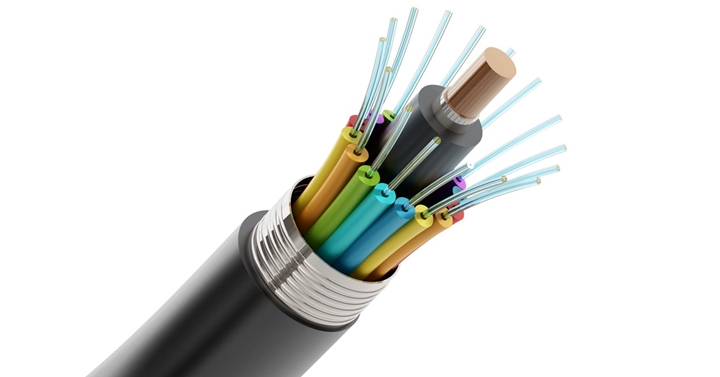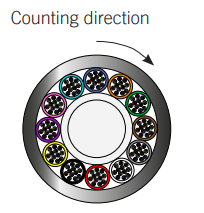Fiber Color Code: Complete Guide to Mastering Identification
For years, we have been using various types of fiber optic cable in labs and data centers. However, it’s common for beginners to confuse different types of fibers, such as 50/125 and 62.5/125 multimode fibers, as well as single mode fibers. To simplify identification, the EIA/TIA-598 standard provides a unified color-coding system for fiber optic cables. In the following sections, we will explore these fiber optic cable color codes and their applications in detail.

What is Fiber Color Code?
The fiber color code is a standardized system used to identify individual fibers within a fiber optic cable, as well as to distinguish between different types of fibers. This system can streamline the intricate process of managing and maintaining networks, guaranteeing efficient data transmission. For example, technicians can quickly trace and manage connections during upkeep and troubleshooting via the fiber color code. EIA/TIA-598, launched by TIA (The Telecommunications Industry Association), is the most commonly adopted standard for fiber color coding, which utilizes a range of distinct colors such as Blue, Orange, Green, Brown, Red, Black, Yellow, etc. for distinguishing fibers. This standard addresses the fiber color codes into three categories for the following different segments: fiber outer jackets, inner fiber sequences, and connectors.
How are fiber optic cables typically color coded?
Outer Jacket Color Code
Colored outer jackets or prints may be applied to outside plant and premises fiber cables, such as fiber distribution cables, fiber optic patch cords, etc., for easy identification and distinction. In EIA/TIA-598, the fiber color code defines the jacket color codes for different fiber types. So for optical fiber cable that contains only one type of fiber, we can easily identify it by its jacket color; unless otherwise specified, the outer jacket of premises cable containing more than one fiber type shall use a printed legend to identify the quantities and types of fibers within the cable. For example "12 Fiber 8 x 50/125, 4 x 62.5/125" indicates the presence of 12 fibers in total, with 8 fibers having a core/cladding size of 50/125μm and 4 fibers having a core/cladding size of 62.5/125μm.
Here are the jacket color codes for different fiber types:
| Fiber Type | Color Code | ||
|---|---|---|---|
| Non-military Applications | Military Applications | Suggested Print Nomenclature | |
| OM1 62.5/125µm Multimode | Orange | Slate | 62.5/125 |
| OM2 50/125µm Multimode | Orange | Orange | 50/125 |
| OM3 50/125 µm (850 nm Laser-Optimized) Multimode | Aqua | Undefined | 850 LO 50/125 |
| OM4 50/125µm (850 nm Laser-Optimized) Multimode | Aqua/Violet | Undefined | 850 LO 50/125 |
| 100/140µm Multimode | Orange | Green | 100/140 |
| OS1/OS2 Single Mode | Yellow | Yellow | SM/NZDS, SM |
| Polarization Maintaining Single Mode | Blue | Undefined | Undefined |
Besides the jacket colors specified in the fiber color code standard, other colors may also be used if the print on the outer jacket can tell the fiber classifications. Such colors should be agreed upon between the manufacturer and the user.
Inner Fiber Color Code
Inside a multi-fiber cable, individual fibers are compliant to fiber color code as well. They are often distinguished from one another by color-coded jackets, buffers or tubes on each fiber. According to EIA/TIA-598, inner fibers are color coded in a group of 12 fibers and they are counted in a clockwise direction.

There are two situations for multi-fiber cables:
The color sequence for inner fibers is as follows:

Connector Color Code
Connectors are also a part of the fiber color code. Since there are different polish styles of fiber end-face, the connectors of fiber jumpers and the mating adapters are color coded for identification. However, the advent of metallic connectors like the FC and ST makes connector color coding difficult, so colored strain relief boots are also used. The boot color may vary among manufacturers.
| Fiber Types | Polish Style | Connector Body |
|---|---|---|
| OM1 62.5/125 | UPC | Beige/Grey |
| OM2/OM3 50/125 | UPC | Beige/Grey |
| OM4/OM5 50/125 | UPC | Beige |
| Single Mode | UPC | Blue |
| Single Mode | APC | Green |
Conclusion
In conclusion, the EIA/TIA-598 standard offers a vital color-coding system that simplifies the identification and management of fiber optic cables. This standard defines the color coding of optical cables from three aspects: outer jackets, inner fiber sequences, and connectors. By using distinct colors for different fiber types and sequences, technicians can more efficiently handle network maintenance and troubleshooting tasks, ensuring accurate and efficient data transmission. Understanding and adhering to these color codes is essential for both beginners and experienced professionals in fiber optic communication.
Related Article: Optimize Network Capacity with Ribbon Fiber Cable
You might be interested in
Email Address

-
PoE vs PoE+ vs PoE++ Switch: How to Choose?
May 30, 2024














